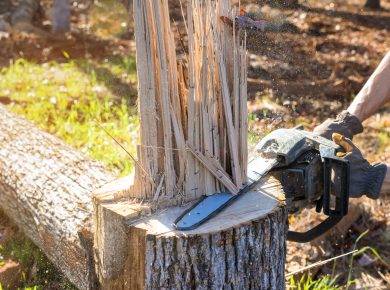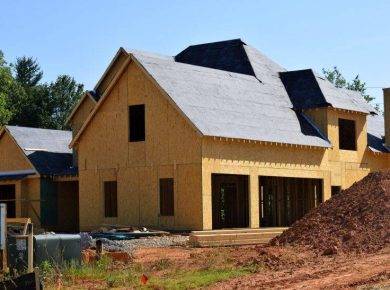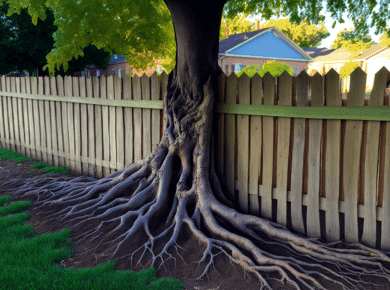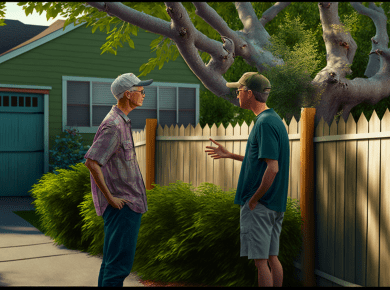Table of Contents
- A neighbor cut down my tree in Montana
- My neighbor cut my tree in Montana
- My tree branches overhang my property in Montana
- My neighbor damaged my tree on my property in Montana
- My neighbor’s tree roots or branches damaged my property in Montana
- Can my neighbor make me cut my tree?
- How can I get my neighbor to cut his dead tree in Montana?
- What happens if I cut my neighbor’s tree down in Montana?
- If your property was damaged click here to see if you might have a case.
A neighbor cut down my tree in Montana
Are you in Montana and a neighbor recently cut down your tree? You now have legal rights to seek compensation under Montana law. To begin with, determine the type of tree cut down, whether it was growing on public or private land, and if the tree was protected under local laws.
If the tree was on your property and protected by local regulations, you may be able to sue your neighbor for damages. To effectively challenge your neighbor in court, it is essential that you can provide evidence of ownership and the legal protection of the tree.
Before pursuing legal action, you should be aware of the potential risks involved and the associated legal costs. If the damage caused to your tree is above a certain amount, you may still seek full recovery for the destruction of the tree.
In any case, you should consult and speak with a local attorney who is experienced in handling tree-related cases in Montana. A legal professional will be able to answer your questions and give you a better understanding of the applicable laws, and determine what actions to take next.
Unfortunately, neighbor tree disagreements can cause hardship and stress. But by consulting with a lawyer who practices in the legal rights related to a neighbor cutting down your tree in Montana, you’ll be in the best position to recover damages and any other compensation due to you under Montana law.
My neighbor cut my tree in Montana
If your neighbor in Montana cuts your tree without your permission, you may have legal rights available to you. Here is a guide to what you should know and do:
1. Understand that bears and other wildlife are protected in Montana and it is illegal to cut down a tree that contains a bear in its den or nests, regardless if it is resulting in damage to your property or other’s property.
2. Consider talking to your neighbor before filing a formal complaint or taking legal action. You may be able to resolve the issue without legal intervention. Explain how the tree was removed without your permission and that you would like it to be replaced.
3. If your neighbor refuses to comply, you can file a complaint with the Montana Department of Environmental Quality. The agency handles tree removal complaints and will investigate the incident.
4. You may also want to pursue a civil lawsuit. Consult with an experienced lawyer to discuss options such as a claim for damages, a legal injunction, or an order to replant the tree.
5. Document any damage that has been caused to your property and keep a record of communication between yourself and your neighbor.
6. You may have to pay a fee to the DEQ if your complaint is found to be valid. You may also be able to recover any attorney’s fees associated with legal proceedings.
By following these steps, you can protect yourself and your property against unlawful tree removal in Montana. It’s important to act quickly and seek the help of an experienced attorney when necessary.
My tree branches overhang my property in Montana
Tree branches overhanging another person’s property in Montana can cause a variety of issues, from shade to property damage from fallen branches. In order to avoid any unwanted conflict or subsequent legal issues, if you own the tree in Montana that is overhanging someone else’s land, it’s important to take the following steps.
First, you’ll need to determine the legal boundaries of your land and the other person’s. This can be done easily by hiring a surveyor to mark the boundaries on your property.
Once you have established the legal boundaries, you’ll need to address the issue of the overhanging branches. If you’re not comfortable hiring a professional tree service to trim them back, you can do it yourself. Start by measuring the distance between the two properties and then use that distance as a guide when you cut the branches. Try to cut them back far enough so that no future growth can breach the boundary. Make sure you dispose of any green waste responsibly.
Additionally, if you decide to hire a professional tree service, make sure you and the other person come to an agreement on the service work and costs before any work is done. Don’t forget to ask for a copy of their insurance to ensure any liability is covered.
Finally, if a dispute does arise between you and the other person, you can refer to your surveyor’s report and prove that the tree branches have been trimmed back in accordance with the legal boundary.
Following these steps should help to avoid an unnecessary and potentially expensive dispute over the tree branches. By taking the initiative to address the problem early on and having all boundary information at hand, you can work with your neighbor to resolve the issue peacefully and amicably.
My neighbor damaged my tree on my property in Montana
If your neighbor damaged a tree on your property in Montana, you may have legal recourse.
First, check your Montana state laws regarding private property damage. Generally, you have a right to seek compensation for any damage caused to your private property. While your neighbor may have committed an unintentional act of negligence, they may still be liable for the damage.
Next, you should contact your local law enforcement agency. If they are unable to help, you can file a claim against your neighbor in small claims court. In order to file a claim, you must collect evidence of the tree damage and photograph the damaged tree or trees. You should also gather any witness statements from neighbors or any other person who was present at the time.
It is also important to request a written apology from your neighbor. If your neighbor does not admit fault, but you prove it in a court of law, your neighbor will be responsible for all damages and costs associated with the trees.
If your case is successful in court, the judge may issue a monetary award to the plaintiff (you). This award could go toward restitution for lost property value, lost of use of the trees, or other damages incurred due to the negligence of your neighbor.
In some true cases, the court may also order the neighbor to pay punitive damages. However, this is not a common outcome.
If your neighbor damaged a tree on your property in Montana, you may have legal recourse. Be sure to stay informed of your rights as a private property owner in Montana and consult local legal experts when necessary.
My neighbor’s tree roots or branches damaged my property in Montana
If you have a neighbor whose tree’s roots or branches damaged your property in Montana, there are steps you can take to seek a resolution.
Step 1: Talk to Your Neighbor
The best place to start is by talking to your neighbor about the issue. Sometimes a friendly, sincere conversation can lay the groundwork for a mutual agreement on how to resolve the problem. Explain what happened and how it affected your property, and come to a mutual agreement about how to repair the damage.
Step 2: Check Montana Law
If the discussion with your neighbor doesn’t lead to a satisfactory result, it’s important to know your legal rights and obligations. The laws for tree damage in Montana vary by city and county, so read up on the applicable laws in your area.
Step 3: Document the Damage
If your neighbor’s tree caused you significant damage, it’s important to document the extent of the damage. Take photos and/or videos of the affected property and the tree. Keep track of repair costs, time spent addressing the issue, and other related expenses.
Step 4: File a Claim
If the damage caused by your neighbor’s tree is significant and your neighbor is uncooperative, you can file a claim with your town, county, or state. Depending on the circumstances, they may be able to require your neighbor to pay the costs of the damage.
Step 5: Consult an Attorney
If the dispute continues to escalate and you need legal advice, consider consulting an attorney. A lawyer can help you protect your rights and represent you in court if necessary.
By following these steps and acting with patience and understanding, it should be possible to reach a satisfactory resolution with your neighbor and repair the damage caused by their tree.
Can my neighbor make me cut my tree?
It is important to understand the limits of your neighbor’s authority if you feel they are asking you to cut down a tree on your property. Unless your neighbor holds official positions such as an arborist or government official, they do not have any legal authority to ask you to cut down a tree on your property.
However, if your neighbor feels that a tree on your property is a hazard or poses a threat to their safety, they may be able to pursue legal action in some cases. If they were to do so, they may be able to get a court order to force you to remove the tree. This can often be done if a court determines that the tree poses a significant threat to public safety, such as if a branch is hanging precariously over a roadway.
If your neighbor is simply asking you to cut a tree down because it is blocking their view or otherwise inconveniencing them, they may have no legal grounds to take action or have you remove the tree. You may consider working with your neighbor to come to a compromise that both of you can agree on.
Your neighbor or local municipality may also have certain regulations or ordinances in place that determine how trees are to be managed on private property. Check with your local town hall or an attorney to learn more about your rights and the particular laws in your area.
Finally, it is important to understand the ecological implications of cutting down a tree. If at all possible, it is best to work with your neighbor to find a way to keep the tree on your property.
How can I get my neighbor to cut his dead tree in Montana?
1. Have a polite and direct conversation with your neighbor about the dead tree in question. If possible, bring a copy of the applicable planning or zoning ordinance and explain to your neighbor that the dead tree poses a threat.
2. If the neighbor is unwilling to cut down the dead tree, contact your county or local extension office in Montana. Extension agents are county agents, who can help you with specific and localized technical advice on various agricultural and horticulture issues, including dead trees.
3. Check with your county or local planning department to see if they have any ordinances regarding dead trees that would mandate the tree’s removal. If so, explain the regulation to your neighbor, and let him know any necessary permit details and other paperwork he’ll need to file.
4. If your neighbor still does not agree to cut the dead tree down, call Montana’s Department of Natural Resources and Conservation (DNRC). The DNRC will be able to determine whether or not the tree is a danger to the public, and instruct the neighbor to take steps to remove it if appropriate.
5. If you cannot successfully work with your neighbor to cut down the tree, contact a professional tree service for assistance. Make sure the tree service has experience working in Montana, as the rules and regulations regarding dead trees in the state may differ from other areas.
By following these steps, you should be able to get your neighbor to cut down his dead tree in Montana. It may take some time, but making sure the neighbor is in compliance with local regulations and understands the safety issues involved will help expedite the process.
What happens if I cut my neighbor’s tree down in Montana?
If you cut down your neighbor’s tree in Montana without their permission, you may face serious legal consequences. Not only will your neighbor have the right to sue you for damages, but the state also has laws on the books to protect people from property damage and trespass.
First, it’s important to note that trees are considered real property in the state of Montana. This means that when someone owns a piece of land, they also own whatever trees are on that property. Thus, under Montana law, it is illegal to willfully cut down your neighbor’s tree without their permission.
If a person is found guilty of maliciously cutting down their neighbor’s tree, they face criminal charges. Depending on the severity of the offense, the penalties can range from a warning or a fine up to actual jail time.
Not only that, but your neighbor can also sue you for damages in civil court. Depending on the circumstances, damages can include the cost of replacing the destroyed tree, as well as any consequential damages caused by the tree’s removal (i.e. decreased property values, disruption of ecosystem).
In addition, any unauthorized removal of trees in Montana is subject to both criminal and civil penalties. Anytime someone tampering with trees (e.g. removing or destroying trees) on public lands in Montana, they can be charged with trespassing and fined.
Ultimately, it’s important to remember that cutting down your neighbor’s tree in Montana without permission is absolutely illegal, and can result in serious legal consequences. The best course of action is to always get permission from your neighbor if you want to remove a tree from their property.



